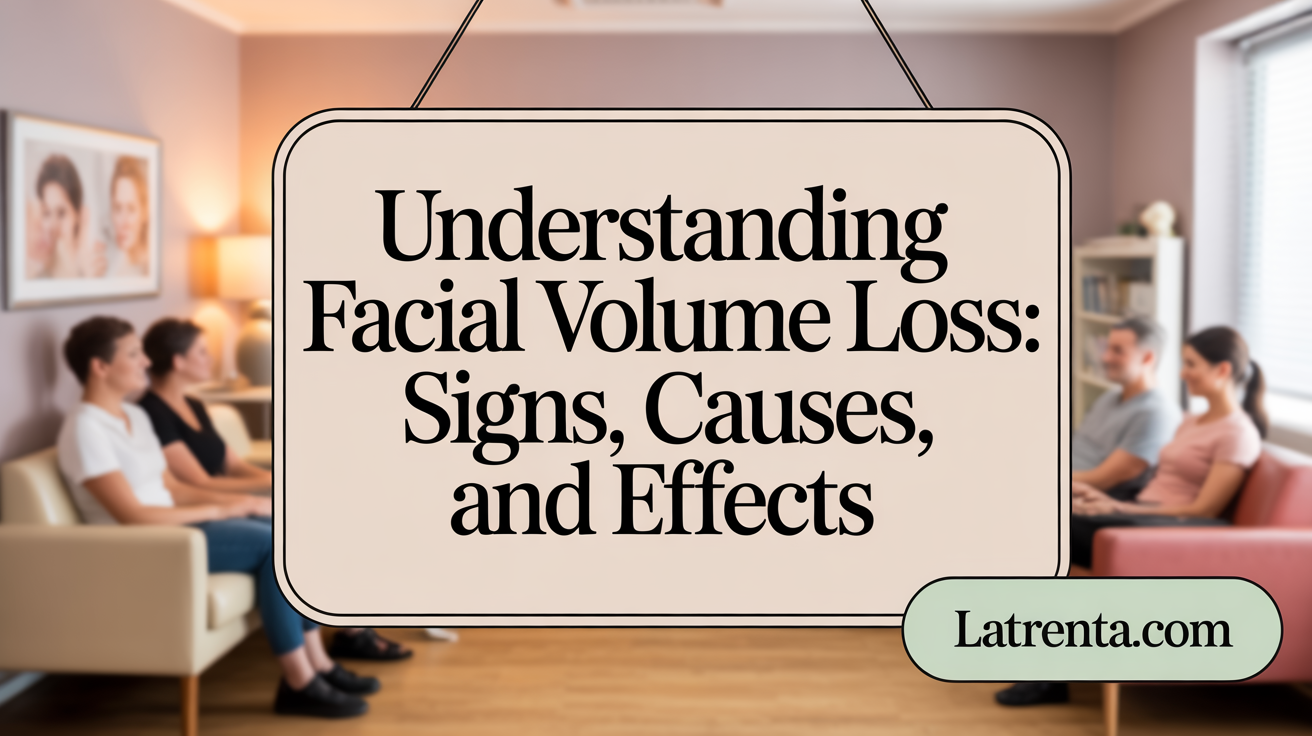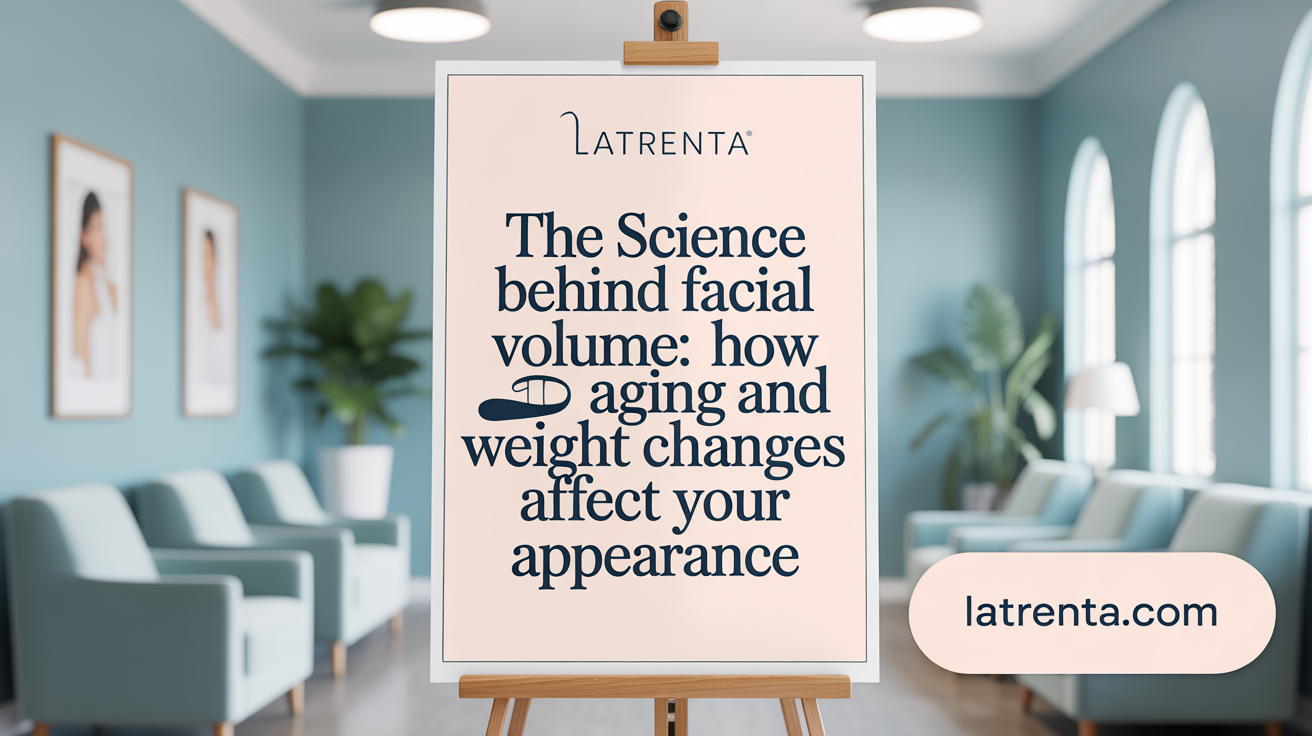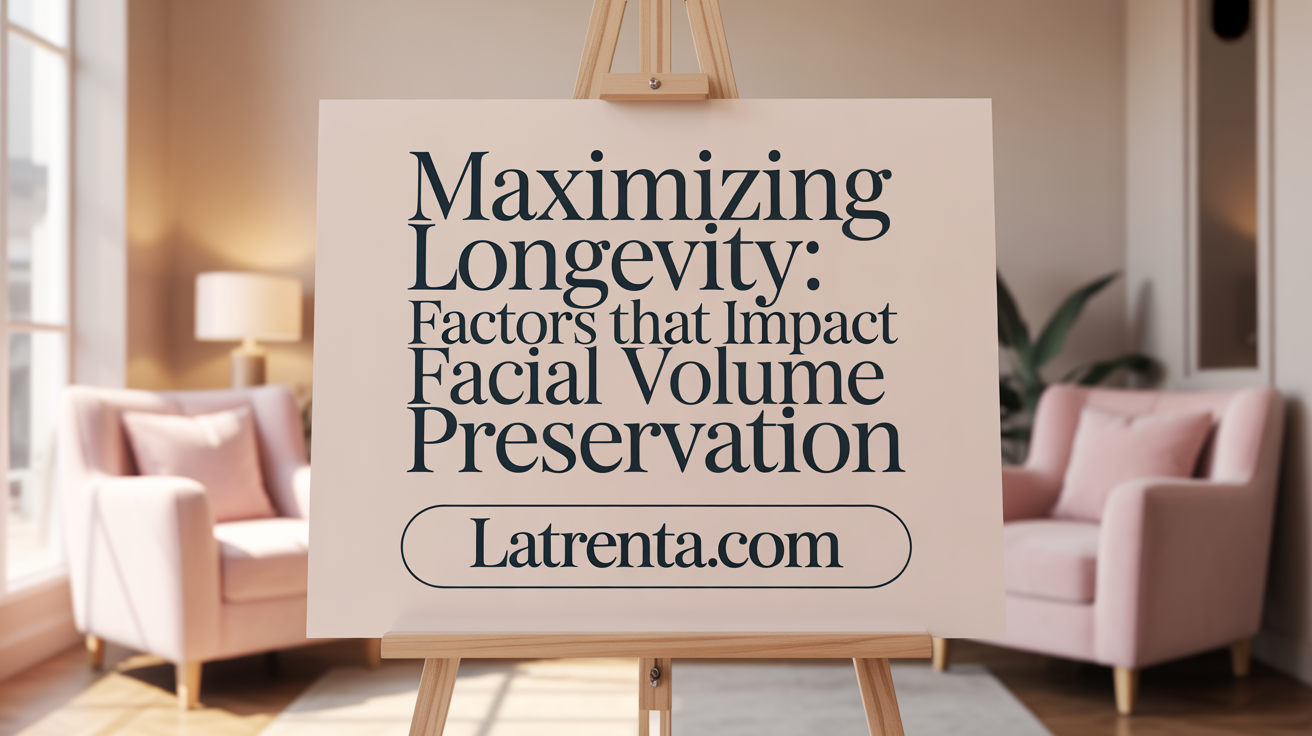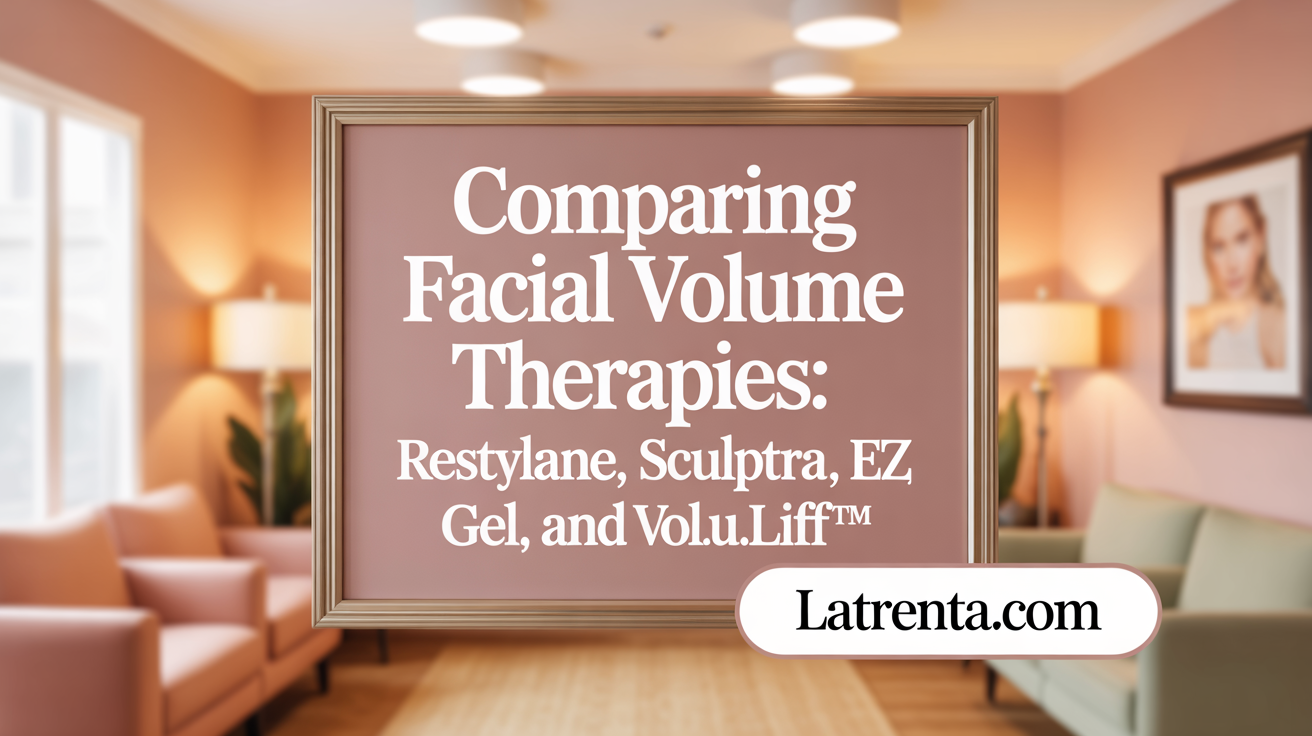Understanding Facial Volume Loss After Weight Loss
Facial volume loss is a common and often distressing consequence of significant weight loss, aging, and other contributing factors. Characterized by hollow cheeks, sagging skin, and deep wrinkles, this volume depletion affects facial aesthetics and confidence. This article explores the causes, signs, and scientifically supported treatments to restore facial volume, emphasizing data on volume restoration rates and longevity to guide patients and clinicians in selecting optimal therapies.
Causes and Clinical Signs of Facial Volume Loss Post-Weight Loss

What is facial volume loss?
Facial volume loss involves the reduction of fat, muscle, and bone in the face. This leads to hollow cheeks, deep wrinkles, sagging skin, jowls, and a double chin, giving an aged or gaunt appearance. It begins subtly in a person’s 20s and then accelerates with age.
How do aging, weight loss, and environmental factors contribute?
As we age, production of hyaluronic acid, collagen, and elastin declines. This deterioration weakens the skin's support structure, causing it to sag and wrinkle. Additionally, environmental factors like sun exposure and smoking further impair collagen synthesis and accelerate skin aging. Weight fluctuations, particularly rapid weight loss, deplete facial fat pads that support the skin, exacerbating volume loss. Medications such as GLP-1 receptor agonists for weight loss—like Ozempic and Wegovy—can lead to quick depletion of facial fat, often resulting in a hollowed appearance.
Typical clinical signs after significant weight reduction
Signs include hollow cheeks, deeper nasolabial folds, sagging skin around the jawline, pronounced jowls, and a decline in overall facial fullness. These changes often occur in the cheeks, temples, under-eye area, and jawline.
Impact of rapid weight loss and medications
Rapid weight loss—often over 35 pounds in six months—can cause notable facial fat loss due to the depletion of small fat compartments. Weight loss medications like Ozempic may induce rapid facial volume reduction, leading to what many refer to as 'Ozempic face.' This process involves substantial loss of fat in the face before the skin and supporting structures can adjust.
Physiological changes in collagen, hyaluronic acid, and fat pads
With age and weight loss, levels of hyaluronic acid, collagen, and elastin diminish. This weakens the skin’s foundation, leading to sagging and the formation of wrinkles, especially in areas like the nasolabial folds and marionette lines. The loss of fat pads diminishes facial contours, contributing to a hollowed appearance.
In summary, facial volume loss results from a mix of natural aging, environmental damage, weight loss, and medication effects. Recognizing its signs early allows for targeted treatments like dermal fillers, laser therapy, and supportive skincare to restore facial harmony and youthful contours.
Overview of Facial Volume Loss Mechanisms

What is the physiological basis of facial volume loss starting in the 20s?
Facial volume loss begins subtly in the 20s, primarily due to the natural decline of essential skin components that support youthful contours. This early stage involves gradual decreases in collagen, elastin, and hyaluronic acid, which are critical for maintaining skin firmness, elasticity, and hydration.
How does the decline of skin components like collagen, elastin, and hyaluronic acid contribute?
As we age, hyaluronic acid (HA) levels decrease, leading to less hydration and plumpness in the skin. Collagen, responsible for skin strength and structure, also diminishes, resulting in sagging and wrinkles. Elastin, which enables skin to stretch and recoil, becomes less effective, further contributing to loose, sagging skin.
What roles do fat redistribution and loss of structural support play?
The face contains fat pads that provide volume and support. With age and weight changes, particularly rapid weight loss, these fat pads shrink or shift, creating hollow cheeks, deep wrinkles, and sagging skin. This loss of structural support makes facial features appear sunken and aged.
How do factors like genetics, smoking, sun exposure, and stress influence this process?
Genetics predispose individuals to faster or more pronounced facial volume loss. Environmental factors such as smoking and sun exposure accelerate skin aging by damaging collagen and elastin fibers. Stress and lifestyle habits can also deplete skin quality, promoting faster breakdown of supportive tissues and leading to an earlier onset of visible volume loss.
Non-Surgical Treatments: Dermal Fillers and Biostimulators for Volume Restoration

What are effective non-surgical treatments for facial volume loss?
Non-surgical options are widely used to restore facial volume and improve skin vitality. Dermal fillers like Juvéderm® and Restylane® are among the most popular, providing instant results that plump the cheeks, smooth wrinkles, and redefine facial contours. These products are primarily hyaluronic acid-based, which not only adds immediate volume but also enhances hydration.
In addition to fillers, biostimulatory injectables such as Radiesse® and Sculptra® stimulate the body’s collagen production over time. Radiesse, made of calcium hydroxylapatite, offers immediate volume and collagen support, lasting up to a year. Sculptra, composed of poly-L-lactic acid, gradually enhances collagen, with results that can persist for up to two years.
Skin tightening and lifting techniques, including high-intensity focused ultrasound (Ultherapy) and infrared light therapies like Zaffiro, encourage collagen and elastin growth, resulting in firmer skin. Complementary treatments such as microneedling and radiofrequency therapies further stimulate collagen for improved skin texture and lift.
Laser therapies such as Fraxel and CO2 lasers also promote collagen forming processes, improving skin firmness and facial appearance without surgical intervention.
Fat Transfer and Surgical Interventions: Natural Volume Restoration Methods

How can facial volume be restored after weight loss without using fillers?
Facial volume loss following significant weight loss can be addressed through natural, non-surgical techniques like autologous fat transfer, known as fat grafting. This procedure involves harvesting fat from other parts of the body—such as the abdomen or thighs—and injecting it into areas of hollowness in the face. Because the patient's own tissue is used, the results tend to look and feel natural with minimal risk of allergic reactions.
In addition to fat grafting, maintaining skin health with topical applications, including retinoids, vitamin C, and peptides, can help support collagen and elastin production. Internal measures such as staying well-hydrated, adopting a nutritious diet rich in antioxidants, and using sun protection can preserve existing volume and prevent further sagging. Also, treatments like platelet-rich plasma (PRP) injections and collagen-stimulating agents like Sculptra promote tissue regeneration and can support volume retention.
Combining these approaches with good lifestyle habits can significantly improve facial fullness, offering a natural alternative to injectable fillers or surgical interventions.
What treatment options are available to add volume back to the face?
Various treatments are designed to restore facial volume effectively. Non-surgical options include dermal fillers—such as Radiesse, Juvederm Voluma, and Restylane—which are injected into specific areas to instantly lift and plump the skin, smoothing wrinkles and enhancing contours. These fillers typically last from six months up to two years, depending on the product and treatment area.
For a more permanent solution, autologous fat grafting remains a popular choice. This involves transferring the patient's own fat cells to the face, offering natural results with the potential for long-lasting fullness, especially when performed after weight stabilization.
Surgical options like face and neck lifts are also available, especially for advanced sagging and skin laxity. These procedures remove excess skin and tighten tissues, providing a more defined and youthful appearance.
Some patients consider implants for targeted enhancement of cheeks, chin, or jawline, delivering structural support and volume with a permanent outcome.
To determine the most suitable method, it is essential to consult with a qualified aesthetic specialist who can recommend a personalized treatment plan tailored to individual conditions and goals. Combining surgical and non-surgical techniques often yields the most comprehensive and natural-looking results.
Additional Information
| Treatment Type | Duration | Main Benefits | Considerations |
|---|---|---|---|
| Fat Grafting | Long-lasting (7-10+ years) | Natural feel and appearance | Need for donor site, longer recovery |
| Dermal Fillers (e.g., Juvederm, Restylane) | 6 months to 2 years | Immediate volume enhancement | May require repeat treatments |
| Facial Implants | Permanent | Structural support | Surgical procedure, healing time |
| Skin Support & Lifestyle | Ongoing | Maintains existing volume | Consistent skincare, healthy habits |
| Surgery (Facelift, Neck Lift) | Long-term | Tightening skin, lifting sagging tissues | Surgical risks, recovery period |
This information underscores the importance of individualized treatment planning to restore facial volume naturally and effectively after weight loss, emphasizing both surgical and non-surgical options based on patient needs and preferences.
Scientific Evidence on Volume Restoration Rates and Longevity of Treatments

What scientific data supports the effectiveness, safety, and longevity of various facial volume restoration treatments?
Extensive research and clinical studies validate the safety and effectiveness of multiple facial volume restoration options. Hyaluronic acid (HA) fillers, such as Juvéderm Voluma and Restylane Lyft, are among the most popular non-surgical choices. These products are designed to restore volume immediately upon injection and are considered safe when administered by trained professionals. They offer predictable results that typically last between 12 to 18 months, depending on the specific formulation and treatment area.
Clinical trials have confirmed that HA fillers can improve facial contour, fill deep lines, and provide hydration, with low risks of adverse effects. Their reversibility adds to their safety profile, allowing potential adjustment or removal.
For longer-lasting results, collagen-stimulating injectables like Sculptra and Radiesse are favored. Sculptra, made from poly-L-lactic acid, prompts the body's collagen production gradually over several months, leading to volume enhancement that can persist for more than two years. Radiesse, with calcium hydroxylapatite microspheres, provides immediate correction and stimulates collagen growth, typically lasting around a year, with some studies suggesting even longer effects.
Fat grafting, especially autologous facial fat transfer, is considered highly effective for durable volume restoration. When performed correctly, it offers a long-term solution with results that can last 7 to 10 years. Proper patient selection and technique are essential to maximize retention and durability.
Research supports these treatments' safety through rigorous clinical trials, FDA approvals, and post-market surveillance. The combination of these modalities often leads to synergistic effects, enhancing overall facial rejuvenation.
Duration of results by treatment type
| Treatment Method | Typical Duration | Supporting Data & Notes |
|---|---|---|
| Hyaluronic Acid Fillers | 6 to 18 months | Clinical trials confirm durability varies by product |
| Sculptra (Poly-L-lactic acid) | Over 2 years | Results appear within 2-3 months, long-lasting |
| Radiesse | Around 12 months (sometimes +) | Collagen stimulation, effects extend beyond 1 year |
| Fat Grafting | 7 to 10 years (with possible later increases) | Dependent on body weight changes and technique |
| PLLA for Volume Maintenance | Up to 7 years | Biostimulatory effects support structural integrity |
Influence of body weight changes on fat graft retention
Research indicates that long-term fat graft survival is significantly affected by changes in body weight. A five-year follow-up study using 3D surface imaging and patient-reported outcomes (via FACE-Q) found that facial volume increases over time were mostly related to weight gain rather than the initial injected volume. A clear association was seen between weight gain (beta coefficient 1.4, p=0.013) and increased facial volume. This underscores that maintaining stable weight is crucial for preserving fat graft outcomes. Repeated procedures may be required for sustained volume, especially if significant weight fluctuations occur.
Clinical trial findings on combination therapies
Recent clinical trials demonstrate that combining different treatments, such as dermal fillers and laser therapies, enhances facial rejuvenation outcomes. For example, using Restylane Lyft or Contour alongside Sculptra produces both immediate and long-term volume improvements. Patients report higher satisfaction, with results lasting longer than individual procedures alone.
These findings support personalized treatment plans that integrate multiple modalities based on individual needs, skin condition, and desired longevity.
This detailed body of scientific evidence confirms that multiple options are available for effective, safe, and durable facial volume restoration, with treatment longevity closely tied to product type, technique, and patient lifestyle.
Factors Influencing Long-Term Volume Retention After Treatment

What factors influence long-term volume retention after facial volume restoration treatments?
Sustaining facial volume after treatments depends on several interrelated factors. First, the type of procedure performed significantly impacts durability. Autologous fat grafting, which involves transplanting a patient's own fat, can last from 7 to 10 years, but its retention rate varies widely—from 26% to 83%—due to differences in technique and measurement methods. Collagen stimulators like Sculptra and PLLA typically provide gradual volume increase that can last over two years, with some evidence suggesting effects may extend longer if combined with other therapies.
Secondly, patient-specific biological factors such as metabolism, aging, and overall health influence how well a treatment maintains volume. For example, a higher metabolic rate or ongoing aging processes may accelerate volume loss, necessitating additional treatments.
Lifestyle choices such as smoking, sun exposure, and weight fluctuations also play crucial roles. Rapid weight gain or loss can significantly alter the volume results achieved, especially since fat grafts can diminish if the patient undergoes considerable weight changes.
Emerging adjunct techniques aim to enhance long-term results. These include platelet-rich plasma (PRP), which may promote vascularization and graft survival, and stromal cell enrichment, which contains stem cells to support tissue regeneration. Although promising, the evidence from current studies remains mixed and not yet conclusive.
Finally, the importance of repeat procedures is recognized. Regular follow-up treatments, often every 6 to 18 months, help maintain optimal volume, especially considering natural aging and lifestyle changes.
| Factor | Effect on Volume Retention | Additional Notes |
|---|---|---|
| Procedure Type | Varies by method | Fat grafting may last years; fillers less so |
| Patient Metabolism & Age | Accelerates volume loss | Faster metabolism can reduce longevity |
| Lifestyle & Habits | Accelerate deterioration | Smoking, sun; weight fluctuations |
| Adjunct Therapies | Potential enhancement | PRP, stromal cells, nanofat may improve survival |
| Need for Repeated Treatments | Ensures sustained results | Regular touch-ups support long-term success |
Search Query for Further Research
"Long term facial volume retention factors after restoration treatments"
Comparative Review of Specific Therapies: Restylane, Sculptra, EZ Gel, and VOL.U.LIFT™

Characteristics and indications of each product
Restylane formulations, including Lyft and Silk, are hyaluronic acid-based fillers designed for immediate volume restoration and hydration. They are suitable for treating concerns like hollow cheeks, under-eye circles, and lip enhancement. Sculptra is a biostimulatory injectable made of poly-L-lactic acid, aimed at stimulating natural collagen production, gradually restoring facial volume for a more natural appearance. EZ Gel is another hyaluronic acid product, known for quick results with moderate volume enhancement. VOL.U.LIFT™, developed specifically for mid-face lifting and volumization, combines features of fillers to lift and reshape facial contours.
Volume restoration capabilities and duration
Restylane products, such as Lyft, typically last between 12-18 months, providing immediate volume correction. Sculptra’s effects develop over 2-3 months, with results that can last over 2 years due to collagen stimulation. EZ Gel offers temporary volume improvements, generally lasting around 6-12 months. VOL.U.LIFT™ offers long-lasting lifting effects, often maintaining results for 1-2 years, depending on individual factors and follow-up treatments.
Treatment nuances and patient suitability
Restylane and EZ Gel are suitable for quick, noticeable improvements, ideal for patients seeking immediate correction. Sculptra is best for patients interested in gradual, natural results and those willing to undergo multiple sessions. VOL.U.LIFT™ caters to patients desiring facial lifting combined with volumization, often used after weight loss or aging-related volume loss. Treatment plans should consider individual goals, skin condition, and the areas targeted, with professional guidance crucial to optimize outcomes.
Potential side effects and safety considerations
Common side effects include swelling, bruising, redness, and mild discomfort at injection sites. Since Restylane and EZ Gel are hyaluronic acid-based, their effects are reversible with hyaluronidase if needed. Sculptra, being a collagen stimulator, may cause lumps or nodules but generally has a good safety profile. VOL.U.LIFT™ injections are performed by trained practitioners to minimize risks such as uneven contour or overcorrection. Proper patient selection and trained operators reduce potential adverse events.
Role in treating post-weight loss facial volume loss
All four therapies can be used to address facial volume loss after weight reduction. Immediate volume loss from weight loss can be effectively corrected with hyaluronic acid fillers like Restylane or EZ Gel for quick improvements. Sculptra’s collagen-stimulating properties support ongoing tissue health, making it suitable for more sustained correction. VOL.U.LIFT™ can restore youthful contours and lift sagging areas, especially in the mid-face. Combining these treatments with skin tightening procedures can enhance results, ensuring a more rejuvenated appearance after weight loss.
Patient Selection, Procedure Details, and Expected Outcomes of Volume Restoration Treatments
What are the procedural details, candidate criteria, and expected outcomes of facial volume restoration treatments?
Facial volume loss can be addressed through various procedures, primarily focusing on restoring the youthful contours of the face. Treatments include minimally invasive options like dermal fillers—such as hyaluronic acid-based products (e.g., Restylane, Juvederm)—and more long-lasting procedures like fat grafting or biostimulatory injectables such as Sculptra®.
Candidates for these treatments typically experience signs of aging or volume depletion caused by natural aging, significant weight loss, or genetic predisposition. They usually seek to diminish hollow cheeks, deepen wrinkles, and lift sagging skin with minimal downtime. It's essential that candidates are in good health, without active infections or skin conditions in treated areas.
The procedural steps depend on the chosen method. Dermal fillers are injected into specific facial regions — cheeks, temples, jawline, or chin — to immediately restore volume and support skin structure. Fat grafting involves harvesting fat from another body part, processing it, and injecting it into trouble spots, offering a longer-lasting, natural correction.
Biostimulatory agents like Sculptra® stimulate collagen production over months for gradual improvement, providing subtle enhancement that can last over two years. Laser therapy, RF microneedling, and skin tightening may be combined post-injection to optimize results.
Expected outcomes include improved facial contours, diminished appearance of wrinkles, and a more vibrant, youthful appearance. Results vary based on the treatment type, area addressed, and individual aging factors. For example, hyaluronic acid fillers typically last six months to two years, while fat grafting can last up to a decade, especially when combined with supportive treatments.
Follow-up treatments are often advised every 6 to 18 months to maintain optimal results. Personalized planning, considering the patient’s age, skin condition, and desired aesthetic, is fundamental for achieving natural and satisfying outcomes.
Comprehensive Facial Rejuvenation Strategies Supported by Evidence-Based Research

What comprehensive facial rejuvenation options are supported by scientific research for volume loss after weight loss?
Addressing facial volume loss after weight loss requires a strategic combination of treatments tailored to individual needs. Scientific studies confirm that both surgical and non-surgical options can effectively restore facial volume.
Non-surgical approaches primarily involve dermal fillers. Hyaluronic acid-based fillers like Restylane, Juvéderm, and RHA are popular for immediate volume restoration in areas like cheeks, nasolabial folds, and jawlines. These treatments are minimally invasive, with results lasting from 6 months to 2 years, and are reversible, offering flexibility for patients.
Calcium hydroxylapatite-based Radiesse provides instant correction and stimulates collagen, with effects lasting up to a year. Poly-L-lactic acid (Sculptra) gradually rebuilds collagen over multiple sessions, with results lasting around two years.
For more permanent solutions, autologous fat grafting is often preferred once weight stabilizes. It involves transferring the patient’s own fat to areas of volume loss, providing long-lasting results—typically 7 to 10 years. Although highly effective, fat grafting outcomes can be influenced by subsequent weight changes.
Emerging therapies focus on muscle tonicity and skin tightening. Radiofrequency (RF) microneedling and laser resurfacing are effective for skin tightening and collagen stimulation, complementing volume restoration. Combining these modalities addresses both soft tissue volume and skin elasticity.
Some innovative techniques involve electrical stimulation of muscles, aiming to enhance facial lift and tone without surgery. These modalities are still under clinical evaluation but show promise in improving facial contours.
In treatment planning, it is crucial to consider the patient's unique anatomical changes. Age-related skeletal support decrease, fat compartment depletion, and skin laxity all impact outcomes.
Recent clinical studies highlight the importance of a multimodal approach—integrating fillers, skin tightening, and possibly surgical procedures—for optimal and natural-looking rejuvenation.
In summary, evidence-based protocols support a tailored, comprehensive plan combining minimally invasive injections, collagen-stimulating therapies, and surgical options, based on individual facial structure and aging progression. This approach maximizes both immediate and long-term benefits, restoring facial harmony after significant weight loss.
Choosing the Right Facial Volume Restoration Strategy
Facial volume loss after weight loss is a multifactorial challenge that can profoundly affect appearance and self-esteem. Fortunately, a variety of scientifically validated treatments—from dermal fillers and biostimulators to fat grafting and surgical options—offer effective volume restoration with varying durations and safety profiles. Understanding the underlying causes, treatment mechanisms, and supporting clinical data empowers patients and practitioners to tailor individualized plans that address specific volume deficits and skin quality issues. Continued advances in combination therapies and regenerative medicine promise even more enduring and natural results. Ultimately, selecting the appropriate treatment depends on patient goals, health status, and lifestyle, with the best outcomes arising from comprehensive approaches supported by rigorous research.
References
- Facial Volume Loss and How You Can Restore It | SkinCeuticals
- How to Treat Facial Volume Loss Due to Weight Loss
- Restoring Facial Volume After Weight Loss: Effective Solutions with ...
- Weight Loss and Facial Volume Loss: What You Need to Know
- Restoring Facial Balance and Other Aesthetic Concerns After ...
- 'Ozempic Face': How Weight Loss Changes the Skin, and the ...
- Volume and patient satisfaction, 5 years of follow up after facial fat ...
- The Utilization of Poly-l-Lactic Acid as a Safe and Reliable Method ...
